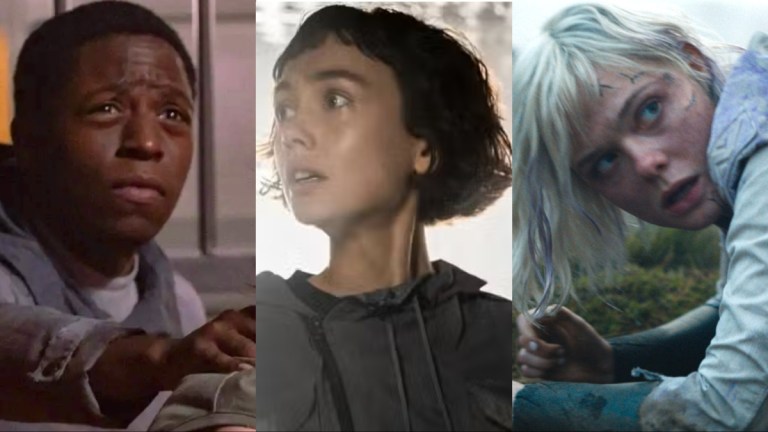Alien: Androids and AI Are Now the Center of the Franchise
Despite its title, the Alien franchise has increasingly revealed its “perfect organism” to have been the robots all along.

This article contains very mild spoilers for the first episode of Alien: Earth.
There originally were never going to be any robots in the world or mythology of Alien. As brilliant as Dan O’Bannon and Ronald Shusett’s initial idea was about a crew encountering an alien organism that nestles itself inside a human host—or “impregnates a man” as Shusett more succinctly described it—the concept of a sinister synthetic presence aboard the ship did not appear in the first or second drafts of 1979’s Alien.
Rather it was producers David Giler and Walter Hill who came up with the concept of Ash, the Weyland-Yutani Corporation spy on the inside; the science fiction equivalent of the worst case scenario for subversive company plants intended to divide and sabotage any employee with dreams of bonuses, cooperative unionization, or even the chance of walking away alive from the job.
In some ways, it was almost a throwaway idea, and yet like the embryo of a xenomorph curled up in your chest cavity, this concept has quietly hibernated below the surface of the Alien franchise for nearly 50 years, growing bigger and bigger until the back-to-back releases of Alien: Romulus in theaters last year and Alien: Earth on FX and Hulu this month. Now it’s crystal clear though: the synthetics are the towering centerpiece of the entire Alien franchise. So much so that in the new TV show, the humans barely matter at all. They’re there, but most of the main characters in the Noah Hawley-created TV series are, in one form or another, synthetic.
There is Babou Ceesay’s Morrow, a cyborg who supposedly was once human but somehow seems even more reptilian than Ian Holm’s infamous Ash in the O.G. Alien. Whereas Ash seemed “off” but benign enough to those not looking closely aboard the Nostromo, Cessay’s Morrow is openly contemptuous of his fellow crewmates on the Maginot, another Weyland-Yutani vessel sent on a doomed mission to acquire dangerous specimens for mysterious motives by “the Company.” Sure enough, Morrow openly and ambivalently watches his colleagues get eaten alive by what Ash once dubbed “the perfect organism.”
Yet Morrow, nor that organism, really appear to be the focal point of Alien: Earth. Instead Hawley seems much more intrigued by the concept of using synthetic technology to create a way to extend life potentially forever. Thus enters “Wendy” (Sydney Chandler), the closest thing the ensemble has to a protagonist. In actuality Wendy was once a human little girl named Marcy, but because she had a terminal illness, a menacing tech “boy genius” at Weyland-Yutani’s rival company was able to manipulate Marcy’s parents into allowing him to upload her consciousness into a robot: a hybrid and the first of her kind.
Because of some sci-fi hand-waving techno-babble, we’re told that so far only children’s minds are malleable enough to make the jump to synthetic living, but the obvious goal is to use artificial intelligence and the blending of man and machine as a pathway to cheating death—a morbid dream chased by real-life venture capitalists and CEOs in Silicon Valley right now. And the fact that Alien: Earth’s first episode opens on title cards explaining the show’s twist on this quixotic fantasy—and the competition between Weyland-Yutani and Wendy’s literal patent owners at Prodigy—suggests where Hawley and Alien: Earth’s real interests lay.
This is not the first time the franchise has pivoted increasingly to paying more attention to the robots. It arguably was always there with the inclusion of Ash, and specifically the way that director Ridley Scott and actor Holm chose to play him. While the producers introduced the appropriately ‘70s cinema twist of there being a synthetic saboteur on the Nostromo, Scott took it one step further into the unnerving and creepy when he crafted unspoken animosity between Ash and Sigourney Weaver’s Ellen Ripley throughout the movie. This subtext culminated in how Scott chose to visualize Ash’s “malfunction.” When the robot attempts murder to Ripley, he shoves a pornographic magazine down her throat.
“I always thought that was interesting. Do androids have sexual urges? This is the closest he gets to a sexual relationship,” Scott previously said of the scene. It’s an idea that seems to have haunted the filmmaker. While the initial spate of Alien sequels from filmmakers like James Cameron and David Fincher downplayed the importance of the synthetic characters, with Cameron mostly using his android side player Bishop (Lance Henriksen) as a red herring who turned out to be a true-blue comrade and friend to Ripley, Scott went all-in on exploring the concept of synthetic sentience and what it means to be human, or at least alive, in Blade Runner (1982). Indeed, Scott purposefully used several of the same props and onscreen graphics from Alien in Blade Runner, teasing to careful-eyed fans that in the director’s mind, the films took place in the same universe.
Obviously this can never be canon given the franchises are owned by separate studios. Yet it’s seemed a goal for Scott to see them linked. Hence when he masterminded the 2010s Alien prequels, both Prometheus (2012) and Alien: Covenant (2017) became preoccupied with Michael Fassbender’s David, a Peter O’Toole-stanning android with desires to play god and create life of his own, just as humanity has done by creating artificial intelligence like David.
A thesis in Scott’s mind is visibly that creation is a cyclical act of hubris and disappointment, culminating in an ungrateful and hostile offspring. After all, while Ash failed to kill Ripley, a woman he might have some incomprehensible attraction toward, Blade Runner’s Roy Batty successfully murdered the father/creator/god who could not live up to Roy’s hopes of offering a pathway to cheating death.
While Blade Runner is not canonically part of the Alien franchise, it nevertheless has shaped pretty much what the series is today. Perhaps in large part because the appeal of the original Alien’s titular creature was its mystery. If you watch that 1979 movie while ignoring the decades of sequels and spinoffs that followed, there really is no telling just how intelligent the creature is, nor what exactly it is doing with the bodies that disappear (unless you watch the director’s cut, which in turn contradicts every movie made afterward). The Star Beast is unknowable. And the more we inevitably are forced to learn about it by returning to this universe, the less scary it becomes, beginning with Cameron’s incredibly entertaining Aliens (1986), a grand action-adventure movie that nonetheless turns the aliens into “bugs.” It even gives them a name that makes them less scary: xenomorphs.
Conversely, the more time we spend grappling with the idea of artificial intelligence and of synthetic living creatures that look like us, but behave decidedly not like us, the more terrifying they become. This is doubly true in the world that Alien: Earth and Alien: Romulus have come into, the latter of which is most interesting when exploring the relationship between protagonist Rain (Cailee Spaeny) and Andy (David Jonsson), a rudimentary and simplistic android she’s known since her childhood. An orphan without family, Rain looks at Andy like her brother, but does he really care about her or can that be programmed away, as another robot attempts to do later in the movie?
That film and this year’s TV series were released in a world where artificial intelligence was no longer an abstract idea. We’re still (thankfully) years or decades away from true general artificial intelligence, or a sentient machine that can think like a human but faster, but the idea is no longer pure fantasy. So Rain’s attachment to her AI companion in Romulus, or Wendy’s existence teasing out a post-death future, becomes far more intriguing to the mind of creators like Scott and Hawley than the monster stalking you on the spaceship.
So much so that this fall’s Predator: Badlands is expected to mark another crossover between the Alien and Predator series… except not in the way comic-con crowds probably would expect. Indeed, the big revelation at this year’s SDCC was that Elle Fanning is playing a pair of synthetic characters built by Weyland-Yutani, the same duplicitous company from all the Alien movies. Apparently both of Fanning’s robots will be different in terms of personalities, with one of them bisected from the waist down and forced to rely on the film’s central Predator (Dimitrius Schuster-Koloamatangi) as her companion and protector on a planet so hostile that even the Predators are now prey. But if we know anything about Weyland-Yutani products, it’s that even a Predator might be wise to distrust the Company’s AI and its sing-song flattery and user engagement.
Whatever the future holds for that partnership, what’s clear is that for actual creators, the most fascinating organisms in the Alien franchise were the robots all along. One might even call them perfect.
